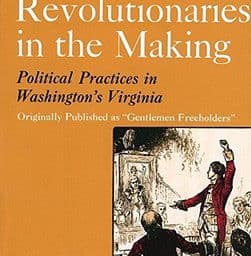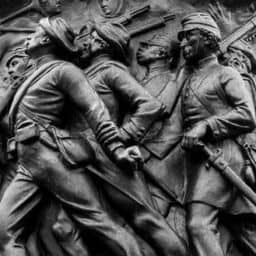McCurry, Stephanie. Confederate Reckoning: Power and Politics in the Civil War South. Cambridge, Mass.: Harvard University Press, 2010.
1. Thesis: Slaveholders that created the “slave power” behind the Confederate States of America neglected the political and social places of white women and blacks to their peril. These neglected groups took advantage of the new necessities of wartime to develop, expand and exert their influence. The war forced the CSA to come face to face with the disenfranchisement of white male voters, white women and black people, to provide accountability and attention to these previously ignored social forces, and to address the strains they placed on political and military efforts to hold the new republic together. (p.310)
2. Structure: Source materials include historical collections, manuscripts, government documents, personal diaries, newspaper article quotations, personal papers and works by other historians. The book moves chronologically through the Civil War with a focus on internal grassroots social and political movements. McCurry starts with the rush to secession despite resistance within. She follows with the development of white women as a social and political force, later turning attention to the great question of what to do with black people during the war. This includes the CSA’s wrangling with the threat of slave insurrection, slave defections, and the very future of the institution of slavery. The book culminates in the dispute over the fundamental view of blacks as either property or persons for military purposes. The resulting divide continued to plague military needs until the fall of the CSA.
3. Evidence:
- White male voter dissent – (Chapters 1&2) – resistance – suppression of dissent – minority pushed through secession without majority support (collusion of governors, cooking the votes, hiding the results, squashing dissent, coercion, vigilante organizations, paramilitary militias for recruitment to secessionist cause), white male voters ignored in many states in lieu of the minority interests, fire-eaters propaganda to sell secession to yeomen and poor whites (fear) – “nonslaveholders as the weakest link figured centrally in fire-eaters aggressive propaganda campaign” (p.43), The 1860 Association “aimed to unify the public opinion of the state and the South behind secession as the proper response to the election of a “Black Republican” president” (p.45), DeBow and populist appeal – rich would escape, poor would have to live with results of emancipation and threat of blacks (p.45), “violation of home and women” (p.46)
- White women movement – women (“secesh ladies”) in occupied territories as spies, their behaviors and the response by Union – Butler’s rules to treat them as “prostitutes (Chapter 3) – right to protection extended to enemy men (p.97), “reluctance to punish women as traitors would never disappear entirely” (p.104) / New class of citizens – soldiers wives – sense of entitlement – a political constituency (Ch. 4) that turned “the sacrifice of their men into a legitimate claim on the state’s protection and resources” (p. 150) with “bended knee and begging letter” (p.160), “matters of labor, subsistence, relief and social justice” (p.163), Conscription Acts drove dependency on the government to protect them and their homes (p.193-196), communication and organizational networks, increasing demands to high officials for men to be released from service to come home to raise crops – “women’s need for food first priority” (p. 198), defend women, families and homes, female organized/led food riots (Mary Jackson) – “bread or blood” (p. 175), violation of social compact of taking care of soldiers wives led to riots (p.179), local Atlanta and other govt. assistance begins (p.181), new entitlement programs for wives and widows – Relief Acts (p.199),
- Black movement – blacks underestimated as property, a pawn, an instrument to be deployed on their behalf, a group that would be naturally loyal to their masters in the war effort without any incentive (p.224), “slaves were domestic enemies against whom the state adopted a posture of self-protection” (p.219), clandestine slave networks of communication, education, literacy, news (p. 228), rise of runaways – “they have very generally got the idea of being emancipated when ‘Lincoln’ comes in” (p.233), slave insurrection/mass exodus fears rise – Second Creek, Miss and Pon Pon River (p.241-245), slavery made for weak states (p.221), scientific racism of Stephens (p. 225), always had to guard slaves around Christmas time (p.292), planters expected army to act as a giant slave patrol (p.297), references to Saint Dominque (p.261), J. Davis plantations – armed revolts (p.257)
- Military/Political issues – “many Confederates believed they could have their cake and eat it too” – not having to give up slaves to the war effort, or if so, could do so and retain property rights over them without recognizing their citizenship or person status (p.332), no regard for “what the negro thinks?” (p.350), “They asked me if I would fight for my country. I said, ‘I have no country'” (p.357), never asked if slaves were willing (p.325), slave impressment issues – slave-master vs. slave-state relationship and reach/authority (p. 219-224, p.267), Speice worried that impressment exposed slaves to political “education” not good for the institution (p.270), what if emancipation for military necessity led to state power to abolish it? – “Confederate impressment of slave men for the military duty of soldiers opened that avenue to the destruction of slavery.” (p.271), “the planter is more ready to contribute his sons than his laves to the war” (p.284), loyalty of slaveholders rest on protection of slave property (p. 299), Pensacola Six – treason trial – property or persons? (p. 303-304), Cleburne/Barksdale Bill/Davis/Lee/Chelsom/Gen. Order 14 – emancipation in exchange for military service (Ch. 8)
4. Convincing? McCurry offers a thorough examination of white women and black people in the CSA to show their influence, which is often overlooked or underestimated, in the fall of the Confederacy. She also makes an interesting claim that I had never noticed or thought of before that makes a lot of sense – the rise of the modern welfare state may have actually had its roots in the CSA, not the USA. I thought this was a very surprising and compelling observation. (End of Chapter 5)
Criticisms? The author tends to belabor certain issues, often in the form of repetitive references to the same materials, quotes or events. This makes an otherwise interesting work at times taxing to read. McCurry also refuses to call the CSA a nation and instead constantly refers to the CSA as a “political project”. Such language, in my view, diminishes the gravity of the period. When reading these words, I feel compelled to equate it with “after school project”, “group project”, “science project”, or some other insignificant and temporary arrangement engaged in for fun.



